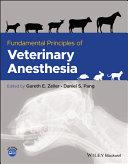Fundamental Principles of Veterinary Anesthesia

Publikace je sestavena speciálně pro studenty veterinární medicíny, veterinární techniky a veterinární lékaře v klinické praxi. Pokrývá klíčové principy veterinární anestezie. Zahrnuje širokou škálu druhů, včetně psů, koček, koní, skotu a prasat. Popisuje vazby mezi fyziologií, farmakologií a klinickou praxí u zdravých a nemocných pacientů.
Publikace slouží jako praktický průvodce pro studenty, aby se mohli připravit na klinickou práci v prostředí soukromé praxe, a jako bohatý praktický zdroj pro praktické lékaře.
Publikace se ideálně používá jako kompletní zdroj sladěný s učebními osnovami. Doprovodná webová stránka je navržena tak, aby snížila zátěž lektorů, kteří potřebují sestavovat prezentace v PowerPointu a zkušební otázky.
Témata v publikaci zahrnují:
Praktické přístupy k perianestetickému období, od posouzení pacienta až po přípravu na anestetickou akci a její úspěšné dokončení.
Anestetické léky dostupné v akademické nebo soukromé praxi se zaměřením na běžně používané léky.
Komponenty anestetického přístroje, průtok plynu přístrojem, jak fungují vaporizéry a jejich funkce.
Principy a techniky monitorování pacienta se zaměřením na běžně dostupná zařízení a jejich aplikace.
Autor: Gareth E. Zeiler (Editor), Daniel S. Pang (Editor)
| Nakladatel | Wiley-Blackwell |
|---|---|
| ISBN | 9781119791249 |
| Vydání | 2024 |
| Vazba | brožovaná |
| Počet stran | 496 |
Fundamental Principles of Veterinary Anesthesia
Comprehensive textbook integrating physiology and anesthesia of multiple species of animals in a unique practical setting.
Fundamental Principles of Veterinary Anesthesia is designed specifically for veterinary students, animal health technicians and veterinarians in general practice. The first edition of Fundamental Principles of Veterinary Anesthesia covers the key principles of veterinary anesthesia, encompassing a wide range of species, including dogs, cats, horses, cattle, and pigs, and establishing links between physiology, pharmacology, and clinical practice in healthy and ill patients.
This text serves as a practical guide for students to prepare themselves for clinical work in a private practice setting, and as a rich, practical resource for those in general practice.
This text is ideally used as a complete curriculum aligned resource, and the companion website is designed to decrease the burden of lecturers who need to compile PowerPoint presentations and review questions.
Topics covered in Fundamental Principles of Veterinary Anesthesia include:
Practical approaches to the peri-anesthetic period, from patient assessment, through to preparing for, and successfully completing, an anesthetic event
Anesthetic drugs available in an academic or private practice, with a focus on commonly used drugs
Components of the anesthetic machine, gas flow through the machine, how vaporizers work and their functionalities
Principles and techniques of patient monitoring, with a focus on commonly available devices and their applications.
| Notes on Contributors | ix |
| Preface | xiii |
| Glossary | xv |
| Section 1: Foundational knowledge Gareth Zeiler & Daniel Pang | 1 |
| Chapter 1: Veterinary anesthesia Tim Bosmans, Roxanne Buck & Gareth Zeiler Chapter | 3 |
| 2: Patient assessment, planning and preparation Jo Murrell & Daniel Pang Chapter | 9 |
| 3: Pain physiology, assessment and principles of treatment H. Nicole Trenholme & Daniel Pang Chapter | 29 |
| 4: Principles of anesthetic monitoring and monitoring equipment Eugene Steffey & Gareth Zeiler Chapter | 49 |
| 5: Inhalation anesthetic delivery apparatus Gareth Zeiler & Daniel Pang | 69 |
| Khursheed Mama & Gareth Zeiler | 97 |
| Chapter 7: Injectable drugs used for premedication, induction and maintenance of general anesthesia Nigel Caulkett & Daniel Pang | 113 |
| Chapter 8: Inhalational anesthetic drugs H. Nicole Trenholme, Gareth Zeiler & Daniel Pang | 131 |
| Abdur Kadwa, Keagan Boustead, Justin Grace, Daniel Pang & Gareth Zeiler | 145 |
| Chapter 10: Other drugs used during the peri-anesthetic period | 159 |
| Section 2: Fundamental aspects of clinical anesthesia Robert Meyer, Stijn Schauvliege, Matthew Gurney & Daniel Pang | 181 |
| Chapter 11: Standards of practice for performing veterinary anesthesia Pamela Murison & Gareth Zeiler | 183 |
| John Hubbell, Nora Matthews & Daniel Pang | 189 |
| Chapter 13: Approach to healthy horse, donkey and mule anesthesia and analgesia Hugo van Oostrom, Samantha Swisher & Gareth Zeiler | 227 |
| Chapter 14: Anesthesia and analgesia of healthy exotic companion mammals, ruminants and pig Sabine Kästener & Gareth Zeiler | 247 |
| Benjamin Brainard, Nicole Trenholme & Daniel Pang | 283 |
| Chapter 16: Approach to a patient in shock Jonathan Lichtenberger, Alicia Skelding & Daniel Pang | 311 |
| Carolyn Kerr & Gareth Zeiler | 339 |
| Chantal McMillan & Gareth Zeiler | 363 |
| Chapter 19: Approach to a patient with renal, urinary or hepatobiliary disease Daniel Pang, Tamara Grubb & Gareth Zeiler | 399 |
| Chapter 20: Anesthetic complications and cardiopulmonary resuscitation | 425 |
| Appendix 1: RECOVER CPR algorithms | 441 |
| Appendix 2: RECOVER CPR emergency drug dose charts | 443 |
| Appendix 3: Checklists | 445 |
| Appendix 4: Peri-anesthetic monitoring sheets | 453 |
| Index | 455 |